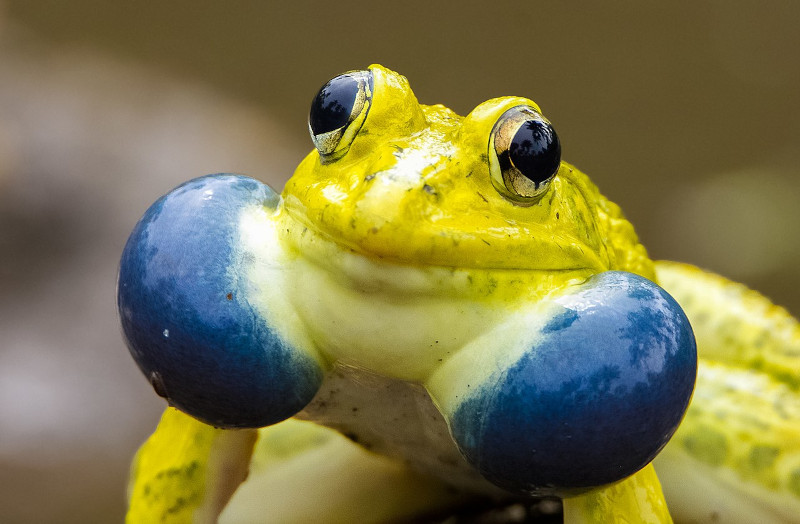
Indian Bullfrog Facts
- Look at the brilliantly contrasting colors of the extraordinary amphibian understandably known as the Indian Bullfrog. It doesn’t look like it could be real, does it? This gorgeous fellow does, however, legitimately represent a relatively large and colorful species of bullfrog.
- Yet, the captivating animal does have several other general titles by which it’s also sometimes referred to. These include such interesting epithets as Asian bullfrog, Indian giant frog, Indus valley bullfrog, Asian river frog, Asian floatind frog, and Tiger frog, among others.
- Inside the scientific community, however, it’s perhaps much better known by its technical moniker. That, however, like so many such terms, remains an extremely difficult one for the layperson to pronounce. It currently holds the formal tag of Hoplobatrachus tigerinus.
- Most unfortunately, this highly unique animal also evolved as endemic solely to an extremely limited portion of the world. The amphibian now seems to have become introduced into Madagascar, though whether intentionally or not presently still remains undetermined.
- There, many people consider this wonder of Nature to be an invasive species, largely due to its truly voracious appetite. In some areas in which the creature appears, though, including the country of Thailand, the marvel of evolution is actually now a commercially farmed species.
- For the moment, the fascinating Indian Bullfrog holds the classification of a species of Least Concern with the IUCN. That status appears on its published Red List. This fortunate situation exists largely due to the seemingly broad habitat range and large population of the animal.
- Regrettably, however, this condition seems quite likely to change, given, to no great surprise, the rapid degree of habitat loss due to human expansion within its native range. The colorful animal also now faces the pressing danger of the ongoing effects of climate change.
Related Articles
Indian Bullfrog Physical Description
The remarkable Indian Bullfrog never fails to capture the instant attention and appreciation of those individuals fortunate enough to encounter one. It does so for reasons other than just its admittedly startling coloring. This awesome amphibian represents one of the largest of all known frogs.
It also follows a pattern of natural development common among many fauna around the world. That’s the fact that it displays a certain degree of the physiological characteristic of sexual dimorphism. Intriguingly, however, in its case this trait manifests itself in two separate manners.
Overall, examples of this animal attain an average body length equaling an impressive 6 – 7 in (15 – 17 cm). As a general principle, females remain on the higher end of this spectrum. Males of the species, meanwhile, usually stay slightly smaller. Though rare, exceptions do sometimes occur.
Nevertheless, it’s undoubtedly the sheer appearance of the amazing Indian Bullfrog that typically garners the most attention. This interest mainly occurs due to a combination of several distinctive features. For one, the skin usually develops as smooth, but with the presence of small tubercules.
Normally individuals display an olive green to brown with darker spots and a lighter underside. During breeding season, males become bright yellow, which makes them strikingly conspicuous. Males also develop large, striking blue vocal sacs on either side of the throat during breeding.
In both genders, however, the body evolved as comparatively stout, robust, and with a broad head and short snout. It also possesses exceptionally large, powerful hind legs, which also boast the typical webbed feet. The animal’s also renowned for its large, protruding eyes with horizontal pupils.
- Kingdom: Animalia
- Phylum: Chordata
- Class: Amphibia
- Order: Anura
- Family: Dicroglossidae
- Genus: Hoplobatrachus
- Species: H. tigeriuns
Indian Bullfrog Distribution, Habitat, and Ecology
The Indian Bullfrog inhabits a comparatively broad swathe of the surface of the globe, despite the suggestiveness of its common name. While its territorial range does include the country of India, the creature actually exists in many regions scattered throughout the continent of Asia.
The great majority of its population dwells within the countries of Bangladesh, Nepal, Pakistan, Myanmar, Afghanistan, Sri Lanka, and, of course, as suggested, India. Surprisingly, smaller known populations of this mighty amphibian additionally appear in the Maldives and Madagascar.
Like many of its countless relatives across the globe, it displays strong and clear preferences regarding its choice of habitat. Nonetheless, it also shows itself to be highly adaptable to different environments. All of these settings, however, still meet the basic requirement of moist conditions.
The marvel of evolution clearly favors freshwater wetlands, ponds, ditches, lakes, and paddy fields. It also often appears in regions of marshy and agricultural lands where water is available. It even frequently proves itself capable of living in various man-made water bodies and roadside pools.
Again following the pattern established by its numerous kindred, the Indian Bullfrog feeds entirely as a carnivore. Its dietary fare includes a wide range of species. It consumes insects, such as grasshoppers, beetles, and crickets, along with smaller frogs, reptiles, birds, and small mammals.
In terms of behavior, it evolved as primarily nocturnal in nature. Breeding season takes place during the local monsoon season. Following mating, the females lay numerous eggs, usually in temporary pools and rice paddies. Sadly, though, the mortality rate among tadpoles remains notably high.
The frog also faces many predators, despite its size. Adults frequently fall prey to such predators as snakes, large birds, mammals, and even humans in some regions. The eggs and tadpoles remain highly vulnerable to large numbers of fish, aquatic insects, and even species of wading birds.
Species Sharing Its Range
Check out our other articles on 5 Amazing Fungi of Asia, Golden Northern Bumblebee, Minerva Springs and Terrace, Texas Horned Lizard, Tongue Eating Louse, Outer Banks, Serval, Weka
